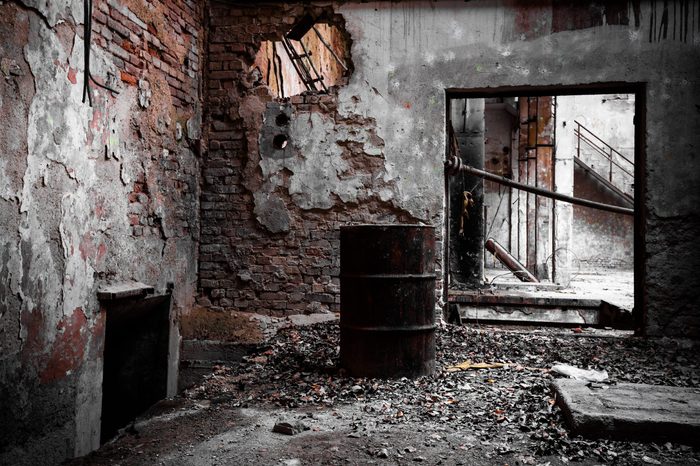
Abandoned places that will give you the chills
As unfortunate as it is when buildings or entire towns fall into ruin, there is something beautiful and irresistible about the eeriness of abandoned places—so much so that there are YouTube channels and blogs dedicated to exploring abandoned places. These crumbling sites have a melancholic beauty, serving as a reminder that nothing lasts forever. After all, abandoned cities were once bustling, abandoned mansions and castles used to be grand homes and abandoned churches were once packed with devoted followers.
Though places become abandoned for a variety of reasons, many are deserted when the primary (sometimes only) industry in the area—like mining or tourism—is no longer profitable. Other abandoned places are the product of war, natural disasters, the decline in railroad travel and shifts in what people do during their leisure time. And so, just in time for Halloween, we’ve rounded up some of the creepiest yet most alluring abandoned buildings, train stations, hotels, islands and towns around the world.
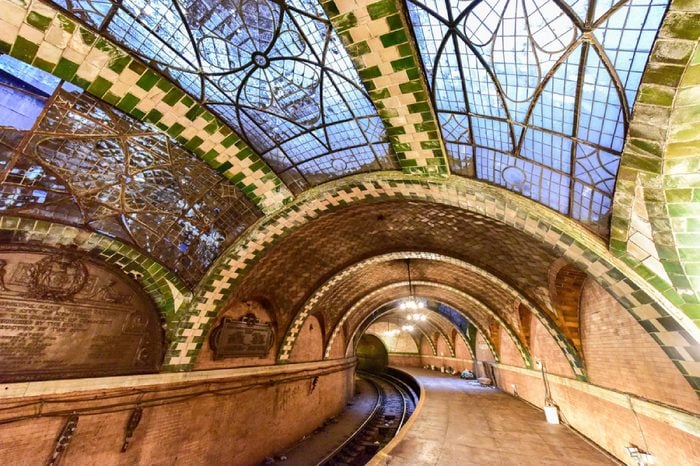
Old City Hall Station
Location: New York City
When the New York City subway opened in 1904, its first official trip departed from a station beneath City Hall in lower Manhattan. The elegant station featured vaulted tiled ceilings, leaded-glass skylights and multiple chandeliers. Sadly, this Gilded Age treasure closed in 1945 because the platform wasn’t long enough to accommodate the new, longer trains. Plus, by that point, only 600 people used the station each day—far fewer than the city’s other stations.
While the station never reopened, you can catch a glimpse of the City Hall station if you ride the downtown 6 train past its terminal stop; the trains still use the City Hall track as a turn-around before heading back uptown. For a better look, the New York Transit Museum offers guided tours for members. It’s one of the abandoned places in New York City you can still visit.
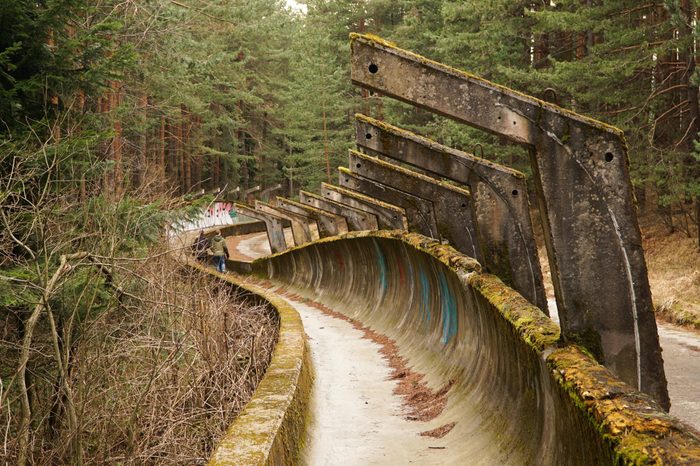
1984 Olympic venues
Location: Sarajevo, Bosnia and Herzegovina
Once the place where gold-medal dreams came true, the Olympic venues in Sarajevo now serve as a reminder of war. When the 1984 Winter Olympics were held, Bosnia and Herzegovina was one of the six republics that made up Yugoslavia, which was the first socialist country to hold a Winter Games. But six years later, the first of a series of regional wars broke out, resulting in the republics within Yugoslavia gaining their independence and, ultimately, the dissolution of the country.
When Bosnia and Herzegovina declared independence from Yugoslavia in 1992, it kicked off a bloody war in the country that lasted until 1996. During that time, Sarajevo was under siege, and some of the Olympic sites—including the bobsled track and ski jump—were used as battlements and strongholds. By the time the war ended, every structure used in the 1984 Olympics had sustained serious damage, leaving creepy photos like this one. The venues sat abandoned for years, but recently, many have been restored and modernized.
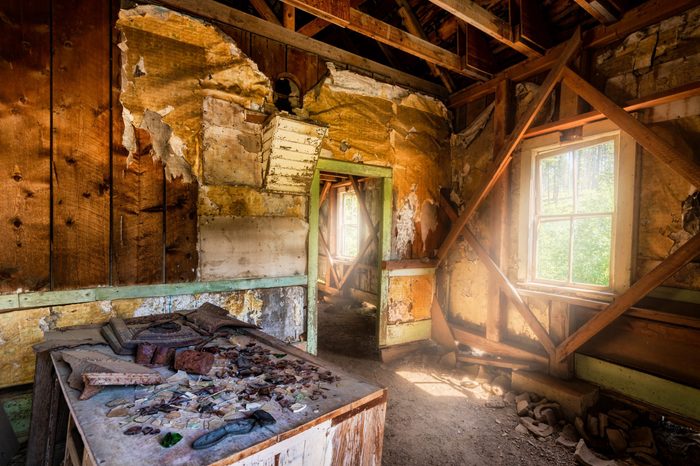
Garnet
Location: Garnet, Montana
Now just a memory of the Old West, the remote town of Garnet, Montana, near Missoula, was once a bustling gold-mining town. When miners began pouring into the area in 1895, they hastily constructed homes, saloons, a mill and a school. At its height in 1898, nearly 1,000 people lived in Garnet.
But neither the gold nor the town lasted. By 1905, most of the mines had been abandoned, and the population shrunk to 150. Then, in 1912, a fire destroyed half the town. By the 1940s, no one was left, with many people leaving everything, including their furniture, behind in Garnet. Now it’s a walk-through museum, and visitors can help support the preservation efforts for this piece of American history. But just because it’s a museum, that doesn’t mean it’s not one of the most haunted places in America.
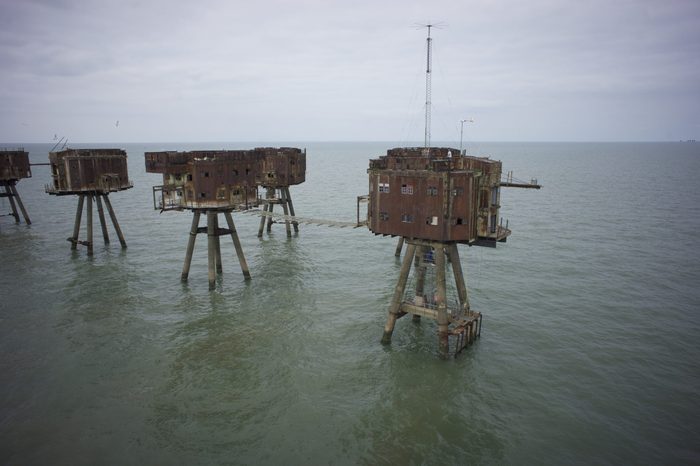
Maunsell Sea Forts
Location: Thames Estuary, England
These rusting otherworldly structures still stand sentinel at the mouth of England’s Thames River, protecting the island from a long-past threat. During World War II, the anti-aircraft sea forts guarded the country, shooting down 22 Nazi warplanes and sinking a submarine. After being decommissioned in the 1950s, they served as the base of a pirate radio station in the ’60s. Like many abandoned places, the Maunsell Sea Forts aren’t open to the public. You can, however, take a boat tour of the Thames Estuary to get a closer look at the bizarre structures. Some people also say the Thames is one of the most haunted bodies of water on earth.
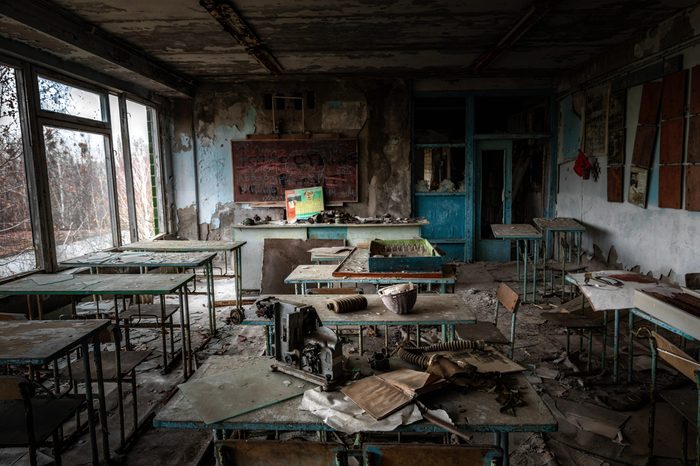
Pripyat
Location: Pripyat, Ukraine
The town of Pripyat may be the most infamous abandoned place on earth, thanks to being close to the site of the 1986 Chernobyl Nuclear Power Plant disaster. Thirty-six hours after the explosion, the city was evacuated, with nearly 50,000 people fleeing for their lives and leaving almost everything behind. You can still see the desolate remains of schools, houses and communities, with clocks frozen at 11:55—the time the power went out.
Although it may not be safe for humans to live there again because of radioactivity (well, at least not for 24,000 years at the actual disaster site, according to some estimates), it’s possible to visit the site briefly on an official tour. These tours saw a boost in popularity in 2019, thanks to HBO’s miniseries Chernobyl. However, Pripyat has been closed to visitors since Feb. 19, 2022, because of the Ukraine-Russia war.

Ta Prohm Temple
Location: Angkor, Cambodia
Not all abandoned places are spooky. Those from hundreds of years ago reflect a more natural cycle of human civilization, with historical ruins reminding us how we used to live, work and worship. Take the Ta Prohm Temple. Unlike the other better-preserved temples in the Angkor area, including the famous Angkor Wat, Ta Prohm was built in the 12th century and deserted in the 14th, after which it was reclaimed by the jungle.
Today, with vines and tree roots climbing over the building, this beautiful mix of human architecture and nature looks like something out of a movie—and, in fact, it was used in the filming of Lara Croft: Tomb Raider. If you’d rather see it in person, you’ll be happy to know that it’s open to tourists. Check out these other iconic movie and TV show locations you can actually visit.
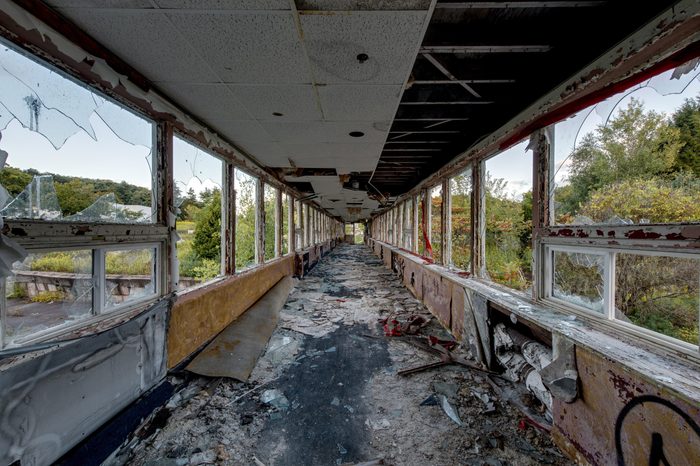
The Pines
Location: South Fallsburg, New York
The Pines was once a sprawling resort with 400 rooms, an indoor skating rink, a pool with a huge concrete arch spanning across it and a “sky bridge” to the restaurant. In the 1950s, it was one of more than 500 hotels in the Catskills that catered to New York’s Jewish families looking for an East Coast vacation. Known as the “Borscht Belt,” the vacation destination declined in popularity as air travel became more common, and now, the ruins of these former hotels dot the countryside. Even though many have been demolished, resorts like The Pines live on in movies and shows like Dirty Dancing and The Marvelous Mrs. Maisel.
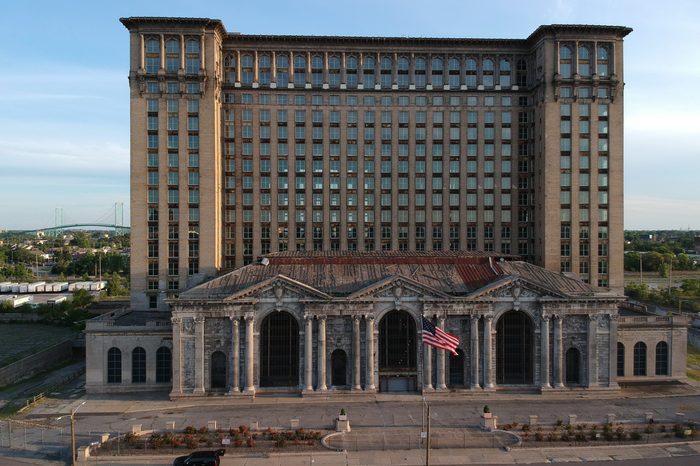
Michigan Central Station
Location: Detroit, Michigan
When it opened in 1913, Michigan Central Station was the tallest train station in the world. Featuring huge arches, marble pillars, copper skylights and bronze doors, it was Detroit’s main railroad depot and one of the growing industrial city’s grandest buildings. But by the 1950s, road trips and air travel grew in popularity, leaving trains—and their stations—behind. After decades of dwindling passenger numbers, Michigan Central Station closed in 1988.
Although its historic status saved it from demolition, the building was considered an eyesore, plundered by looters and defaced by vandals. Things began to change in 2018, when the Ford Motor Company purchased the iconic station and the surrounding grounds, which are now a 30-acre mobility innovation district. Restorations on Michigan Central Station are currently underway, with the first phase expected to open in mid-2023.
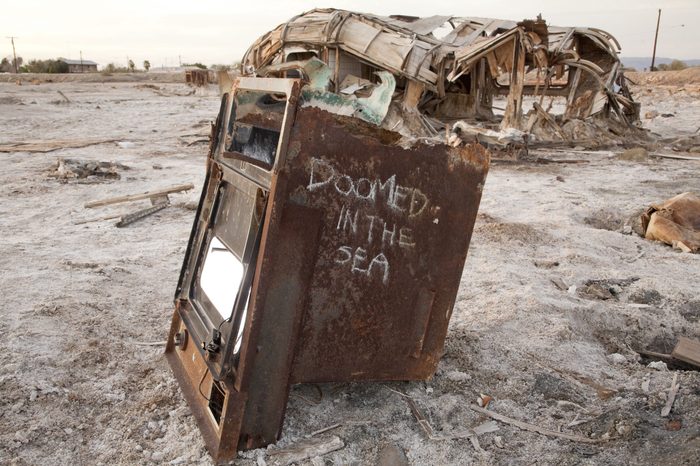
Bombay Beach
Location: Niland, California
This short-lived resort area and its abandoned hotels have a bizarre history. The Salton Sea—once California’s largest lake—formed in 1905 when the Colorado River flooded a desert basin. In the 1950s and 1960s, it was a popular vacation spot, complete with resorts, known as the Bombay Beach community.
But soon, increasing salinity in the lake rendered life unsustainable, resulting in dead fish washing up onshore and a horrendous stench; the lake also became polluted from agricultural runoff. It wasn’t long before Bombay Beach was abandoned. Today, it’s home to a small community of artists (population: 231), their homes and multiple art installations.
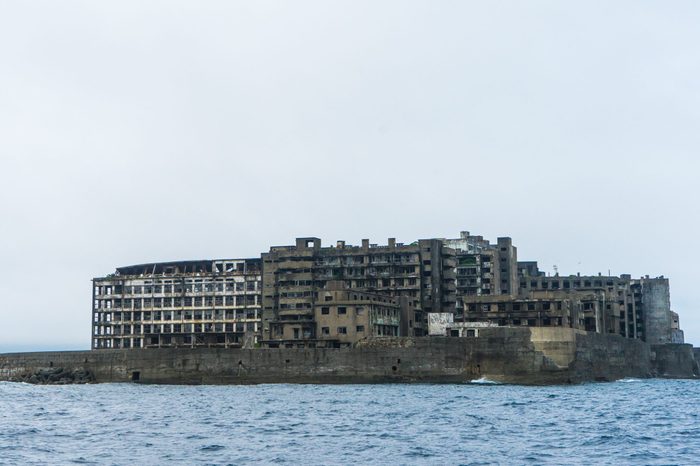
Hashima Island
Location: Hashima Island, Japan
Also known as “Battleship Island” for its shape, the 16 acres of concrete and steel stands are a remnant of Japan’s rapid industrialization. With more than 5,000 people crowded into high-rise apartment buildings in the mid-20th century, Hashima was one of the most densely populated places on earth. Many people who lived there were coal miners and their families, so when the mines closed in 1974, Hashima Island was quickly abandoned.
But that’s only the most recent chapter in Hashima Island’s history. In the 1930s and 1940s—including throughout World War II—the coal mines were operated using forced Korean labor. At least 800 Koreans were forcibly sent to Hashima Island to work the mines during World War II; 134 reportedly died while working there.
Today, visitors can take tours of Hashima Island to see the crumbling buildings. You can also catch the island in the 2012 James Bond film Skyfall.
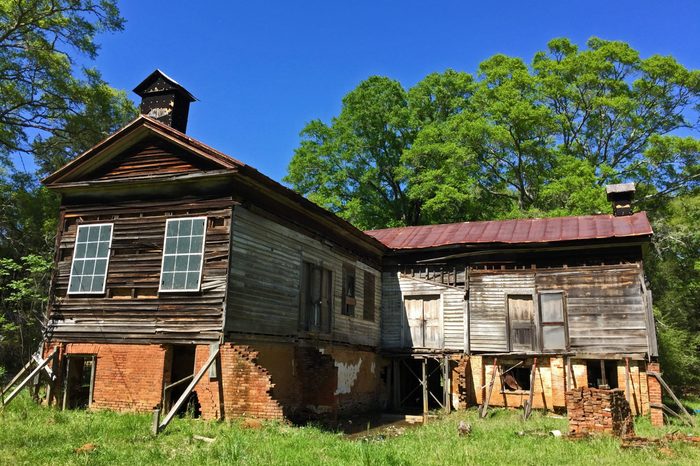
Old Cahawba
Location: Cahawba, Alabama
It’s hard to believe, but this site that’s now littered with dilapidated cabins was once the capital of Alabama. The history of Old Cahawba goes in fits and starts: Chosen as the state capital in 1820, the town was abandoned after flooding, and the capital moved to Tuscaloosa in 1826. But Old Cahawba reemerged as a distribution point for cotton shipping when a new rail line was built in 1859.
During the Civil War, the railroad tracks were ripped up, and the town hosted a prison for Union soldiers. After the war, another flood drove the remaining residents out. While the town again found new life as a community for former enslaved families, it was short lived. By 1900, all of Cahawba’s buildings were deserted, burned, collapsed or dismantled. Despite the fact that nearly all the town’s structures were gone by 1930, it wasn’t unincorporated until 1989. Since then, the town has been in ruins but is now enjoying yet another rebirth as an archaeological park.
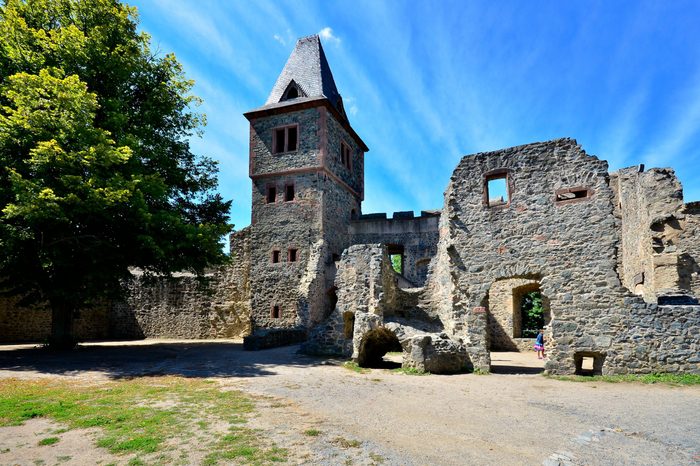
Castle Frankenstein
Location: Mühltal, Germany
You can find abandoned places all over Europe, but the history of 13th-century Castle Frankenstein is creepily curious because of its connection to one of Halloween’s spookiest creatures. A real-life scientist named Johann Konrad Dippel conducted strange experiments here in the early 18th century—including, reportedly, on corpses. Could Dippel have inspired the fictional scientist who shares the castle’s name, and his monster?
Although Frankenstein author Mary Shelley never mentioned the castle in her journals, she did pass it on a trip down the Rhine in 1814. Did she hear stories about Dippel from locals? Or perhaps her stepmother, a translator for the Brothers Grimm, read the tale and passed it on? In any case, after being abandoned in the 18th century and rumored to be the home of a dragon, the ruins of the castle are now open to tourists.
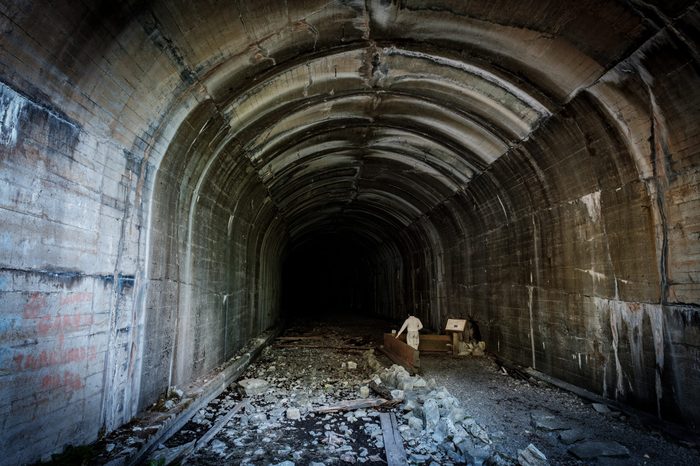
Iron Goat Trail
Location: Skykomish, Washington
A lovely hiking trail passes by the site of one of the worst train accidents and the deadliest avalanche in U.S. history. Known as the Wellington Avalanche Disaster, the incident occurred in 1910, when two snowed-in trains on the Great Northern Railroad were knocked off their tracks by what one witness described as “white death.” The snow buried the trains in the canyon below and killed 96 people.
After the accident, safer tracks and tunnels were built, but the old abandoned ones remain. Some say they’re haunted, with hikers reporting they’ve heard screams and other scary sounds around the crash site. It’s not safe to go into the tunnels, so don’t try it, but you can take a peek from the outside.
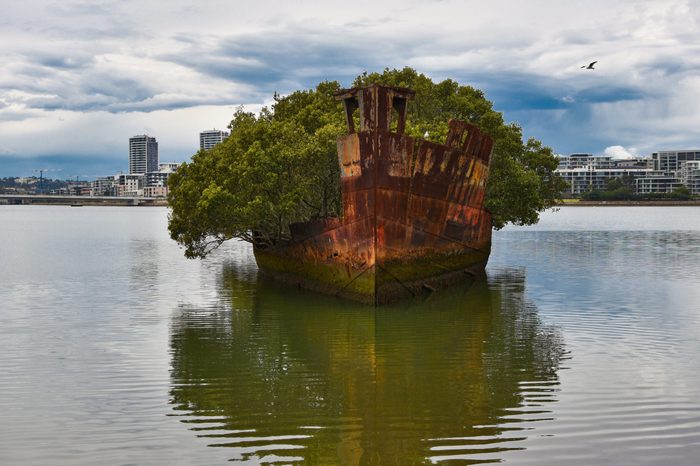
SS Ayrfield
Location: Homebush Bay, Australia
This is not your average shipwreck. The SS Ayrfield, built in 1911 and used as a supply ship during World War II, was left to rot where it was moored in Homebush Bay after being decommissioned in 1972. What makes the bay even creepier is that the SS Ayrfield is only one of many wrecks in the harbor.
This industrial area was contaminated with toxic waste, but it was eventually cleaned up and revitalized for the 2000 Sydney Olympics. Today it’s home to several of the city’s suburbs, but the SS Ayrfield remains in Homebush Bay—now reclaimed by mangrove trees and known as the “floating forest.”
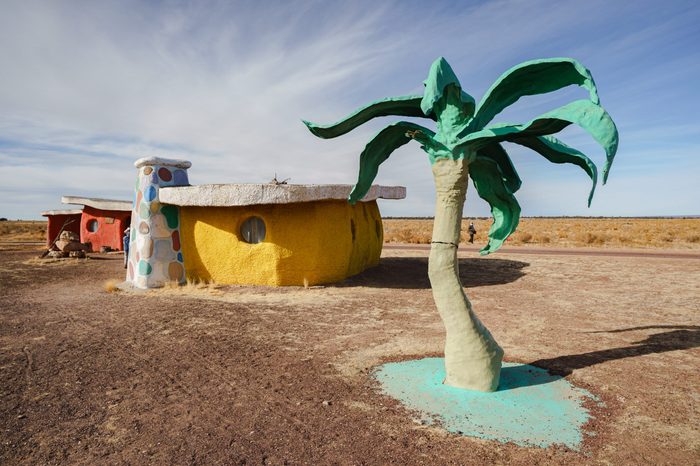
Bedrock City
Location: Williams, Arizona
Ever since Bedrock City opened on Route 66 just outside of Williams, Arizona, in 1972, a large sign featuring cartoon favorite Fred Flintstone has welcomed people to the unusual campground. Providing RV parking as well as places to camp in a tent, Bedrock City was best known for its brightly colored buildings and large statues and locations inspired by the TV show. Though it was technically still in operation as a campground until the summer of 2019, it was basically considered a quirky abandoned site and roadside attraction.
Now under new ownership, it reopened in 2020 as Raptor Ranch, a campground and park displaying birds of prey. And while many of the iconic structures have been demolished, a few—including the popular brontosaurus slide—have become fixtures in this new iteration. Campground guests have free access to the former Bedrock City, but anyone can visit for a small entrance fee.
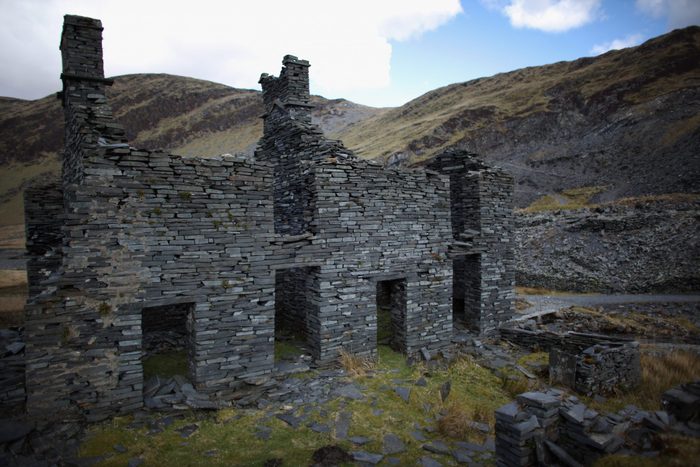
Gwynned slate quarries
Location: Blaenau Ffestiniog, Wales
Long known as “the town that roofed the world,” Blaenau Ffestiniog began to take shape in the 18th century following the discovery of a valuable slate vein in the area. It wasn’t long before multiple slate quarries opened near the town—including in Gwynned—eventually making it one of the largest slate centers in the world, with more than 4,000 people working in the quarries. The surrounding community grew with the slate industry. By 1901, Blaenau Ffestiniog was the second-largest town in northern Wales.
Despite its remote location, the town was quick to modernize, and in 1902, Blaenau Ffestiniog became the first town in Britain to have electric streetlights powered by water. The town made history again during World War II, when priceless works of art from the National Gallery and Buckingham Palace were transferred to one of the quarries for safekeeping, in the event that London was bombed. Many of the quarries were deserted in the 1960s, and today, you can explore some of the area’s abandoned places, which are now located within Snowdonia National Park.
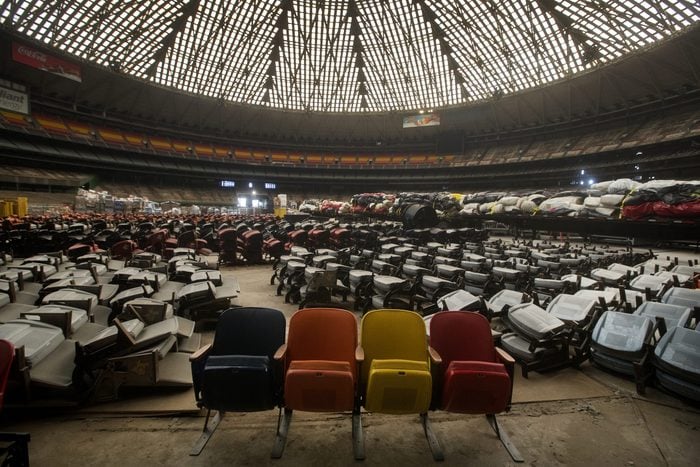
The Astrodome
Location: Houston, Texas
Before the Astrodome became a shelter to 25,000 people during Hurricane Katrina, it was known as the “Eighth Wonder of the World.” That’s because when the Astrodome opened in 1965, it was the world’s first indoor, air-conditioned domed stadium. The Astrodome was also the first stadium to install an artificial playing surface, which came to be known as Astroturf.
For more than 40 years, the Astrodome hosted everything from two professional sports teams—the Houston Astros and Houston Oilers—to the 1992 Republican National Convention, Evel Knievel’s 1971 world-record-setting jump and performances by greats including Judy Garland, Elvis and Selena. But between 1996 and 2006, all the tenants moved out, and in 2008, the city shuttered the landmark, which has remained vacant to this day.
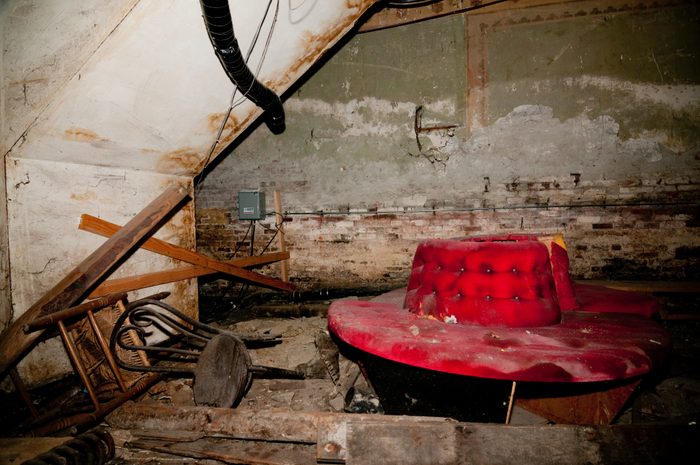
Seattle Underground
Location: Seattle, Washington
Beneath Seattle’s Pioneer Square neighborhood lies a long-abandoned subterranean city. It was constructed after the Great Seattle Fire of 1889 destroyed 25 blocks of the neighborhood’s central business district. When it came time to rebuild, the city constructed eight-foot retaining walls on both sides of the streets, filled in the space between the walls and paved over everything, leaving the streets one story higher than before.
But before the new streets were finished, some business owners had already reconstructed their buildings—not realizing their street-level ground floors would soon be underground. The result was a network of tunnels and passageways under Pioneer Square. While they were open initially, city officials condemned the subterranean maze in 1907, fearing they could play a role in spreading plague. These underground ruins were largely forgotten, almost like a lost city, until a local historian researched the passageways, restored some to what they might have looked like at the turn of the century and started offering public tours in 1965. The company still offers tours today.
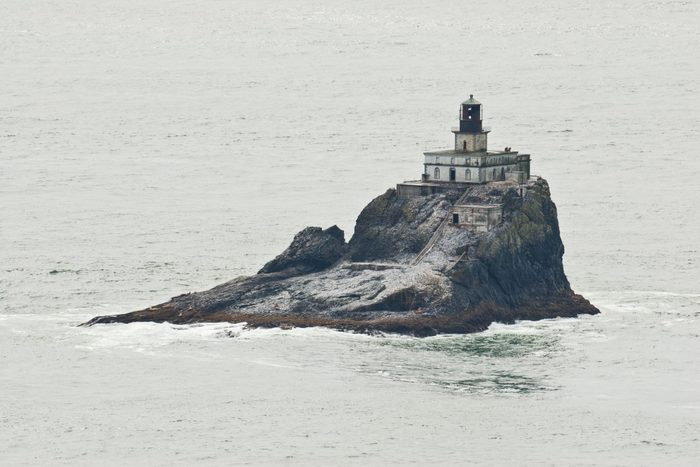
Tillamook Lighthouse
Location: Cannon Beach, Oregon
For nearly 140 years, the Tillamook Lighthouse has been standing guard over the Pacific Ocean, just over a mile from Oregon’s North Coast. Construction of the 62-foot-tall lighthouse and adjoining lightkeeper’s quarters began in 1879, and the lantern in the lighthouse was lit for the first time in 1881.
In 1957, the lantern was extinguished for the final time, and Tillamook Lighthouse was decommissioned. Between 1980 and 1999, a group of real estate investors owned the lighthouse and operated it as the Eternity at Sea Columbarium, which served as the final resting place for approximately 30 urns containing human cremains. Given that morbid chapter in the Tillamook Lighthouse’s history—as well as the countless shipwrecks that occurred in the surrounding waters over the years—it’s considered haunted, like many abandoned places with their own ghost stories, and has earned the nickname “Terrible Tilly.”
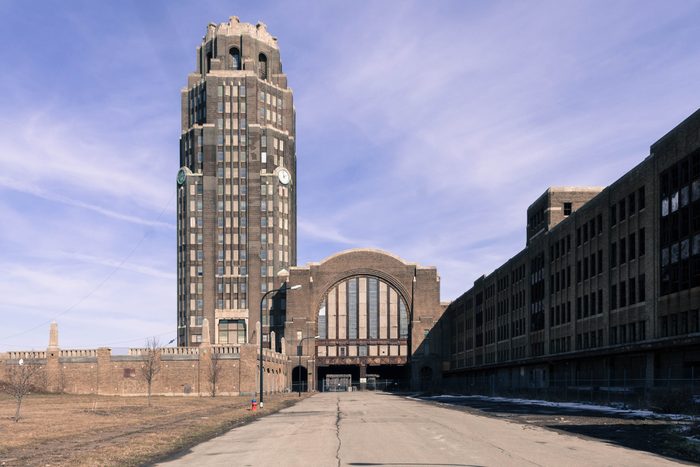
29 Buffalo Central Terminal
Location: Buffalo, New York
When Buffalo Central Terminal first opened its doors in 1929, its modern Art Deco design perfectly suited a thriving city optimistic about its future. Unfortunately, that future would include the start of the Great Depression only two months later. Still, the next two decades brought a high volume of traffic through Buffalo Central Terminal, particularly during World War II.
But life in post-war America was all about automobiles, and train ridership declined nationwide, leaving little use for expansive terminals like the one in Buffalo. The station changed hands a few times, with Amtrak eventually taking over and overseeing its closure in 1979. The structures continued to be bought and sold for the next two decades, all while sitting abandoned and falling into disrepair. Things changed in 1997, when the Central Terminal Restoration Corporation (CTRC) purchased the property and began restoring the site. You can see similar Art Deco vibes in some of the most beautiful post offices in the country.
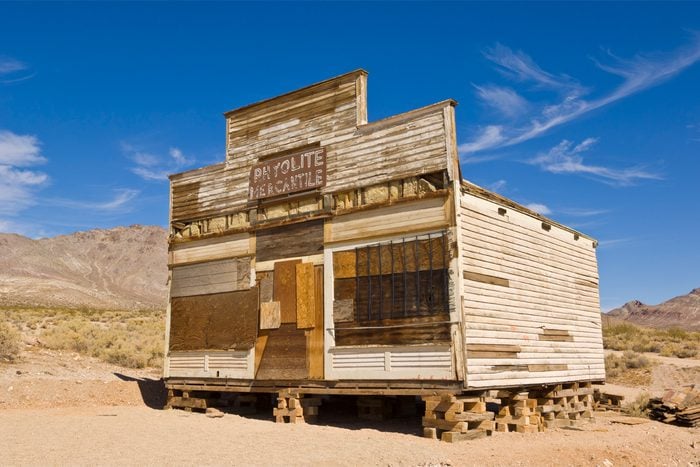
Rhyolite
Location: Nye County, Nevada
Like many mining towns, Rhyolite, Nevada, seemingly sprung up overnight after gold was discovered nearby in 1905. But unlike other mining towns, which were primarily populated by men seeking their fortunes, Rhyolite grew to the point of being home to families and developing as a community. In addition to a school, the town had its own opera house, symphony and ice cream parlor. It was also an important commercial center, with hotels, stores, a stock exchange, electric plants, a bustling red-light district and more. But the good times didn’t last: Rhyolite’s mines began closing in 1910, and by 1915, the town was almost completely abandoned.
Rhyolite never completely faded away, though, thanks to its most intriguing structure: a house made from 50,000 beer and liquor bottles. A local miner named Tom T. Kelly built this home, appropriately known as the Bottle House, in 1906. In 1925, Paramount Pictures decided to use the Bottle House as a movie set and paid for parts of it to be restored, and it continues to be one of the most unique abandoned houses. Today, the Rhyolite Ghost Town is operated by the Nevada Bureau of Land Management, and it’s free to visit seven days a week.
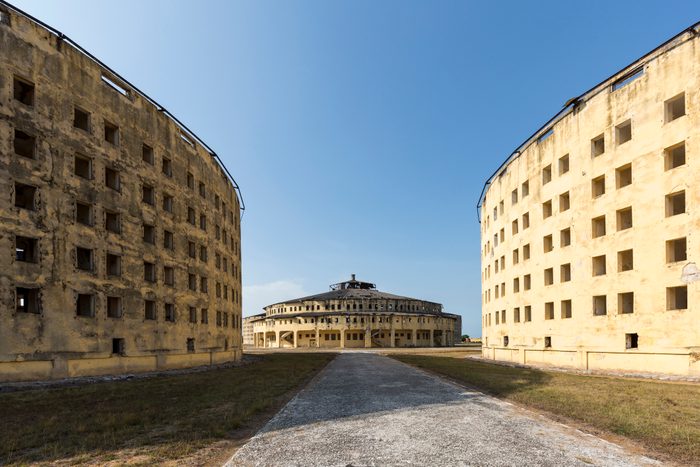
Presidio Modelo
Location: Nueva Geron, Cuba
Located on a small island off the south coast of Cuba’s main island, Presidio Modelo (which translates to “Model Prison”) opened its doors in 1931. It consists of several buildings, including five intimidating five-story circular structures that look like stark, modern versions of the arenas of ancient Rome—except that instead of rows of stadium seating, the outer walls of the buildings held prison cells. A single prison guard stationed in an elevated tower in the center kept watch over upward of 1,000 incarcerated people at a time.
This style of correctional facility was only used in a handful of prisons around the world, including the Stateville Penitentiary in Illinois, which served as the model for Cuba’s Model Prison. While in operation between 1931 and 1967, the Model Prison housed many of the leaders of Cuba’s revolution, including a young Fidel Castro, who served less than two years of a 15-year sentence between 1953 and 1955. The Model Prison fell into disrepair following its closure, and today, it’s a national monument and home to a small museum.
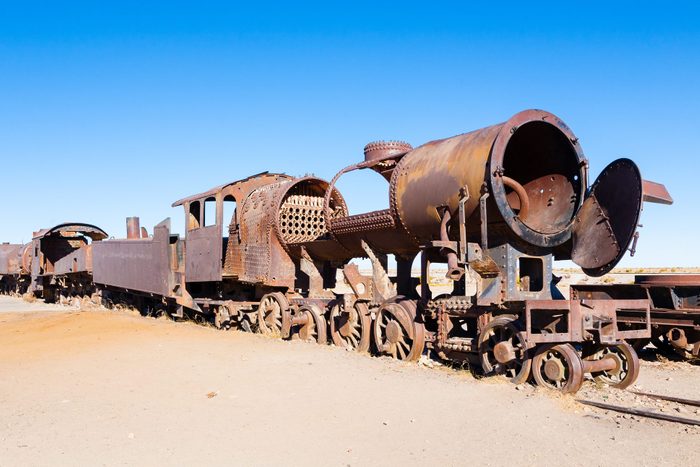
Cementerio de Trenes
Location: Uyuni, Bolivia
Along with abandoned places, there’s also something fascinating about the rusted-out remains of various modes of transportation. That’s why train enthusiasts who want to get up-close-and-personal with once-mighty steam engines have been making pilgrimages to a remote part of the Bolivian desert, where the “Train Graveyard” is located.
How did these trains get here? In the 19th century, they were a crucial part of Bolivia’s mining industry, used to haul minerals to Chilean ports on the Pacific Ocean for export. But when the mining industry declined in the 1940s, the trains were no longer needed. Instead of decommissioning them and selling them for scrap, the railway companies left them in the desert, where they’ve been sitting ever since. Though not a major tourist attraction itself, Cementerio de Trenes is located only a few miles away from the world’s largest salt flat (Salar de Uyuni), so there’s a steady influx of visitors to the area.
For a more literal take on the graveyard theme, these are the oldest cemeteries in the United States.
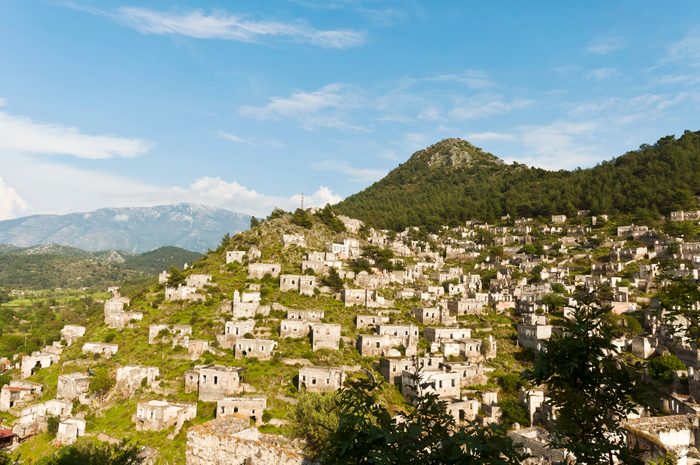
Kayaköy
Location: Muğla Province, Turkey
Despite its location roughly three miles from the bustling resort town of Hisaronu, the streets of Kayaköy are eerily quiet. That, however, wasn’t the case a century ago, when the town was home to a population of about 10,000 people. But what sets Kayaköy apart from other abandoned towns isn’t architecturally important buildings or remarkably intact homes. Rather, it’s unique because of its former inhabitants: Anatolian Muslims and Greek Orthodox Christians, who lived peacefully side-by-side.
The two groups settled here in the 14th century. The Christians, most of whom were artisans, made their home on a hillside, while the Muslim community farmed the land in the valley below. The groups thrived economically because of their ability to trade with each other, and they benefitted from interacting socially as well. That is, until the end of the Greco-Turkish War of 1919–1923. Kayaköy’s 6,500 Christian residents were forced out of their homes and relocated to Greece. Meanwhile, Muslims living in Greece were sent to Turkey—the idea being that each country have a single, primary religion moving forward.
Then, in 1957, a 7.1 magnitude earthquake destroyed much of the town. The Muslim sections in the valley were eventually rebuilt, but the hillside that was once home to the town’s Christian community remains in ruins.

Kolmanskop
Location: Namib Desert, Namibia
In 1908, a Namibian railroad worker found what turned out to be diamonds in an uninhabited part of the Namib Desert, prompting legions of prospectors to swarm the area. Diamonds were so plentiful that “mining” them often involved crawling on the ground to pick them out of the sand. By 1912, the town of Kolmanskop, which was part of the colony of German South West Africa, had formed and was producing 11.7% of the world’s diamonds. In its heyday, Kolmanskop was home to an ice factory, a post office, several bars, a bowling alley, a concert hall and a state-of-the-art hospital.
But German officials didn’t want Indigenous Namibians profiting from the diamonds, so they designated much of their colony in Namibia as a “restricted zone,” displacing the tribes that lived on the land and forcing them to live in barracks and work the diamond mines. By the 1930s, Kolmanskop’s diamond fields were depleted, and most of the prospectors and miners relocated. By 1956, the town was completely abandoned. Most of the town’s structures were built in a German style, making photos of them being swallowed by desert sand even more surreal.
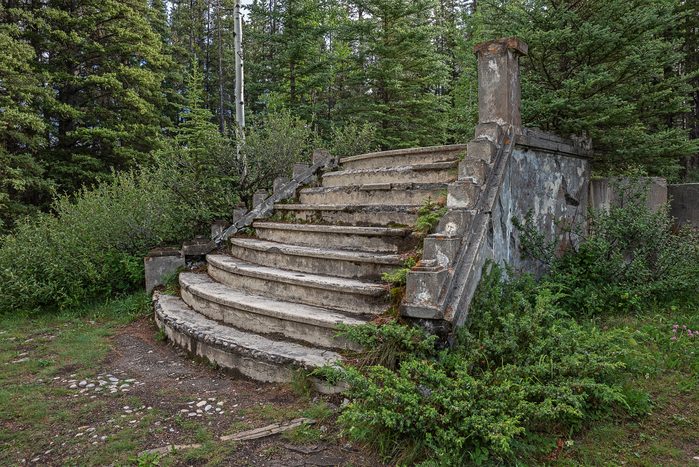
Old stairway at Bankhead
Location: Banff National Park, Alberta, Canada
You’ll find these stairs that lead to nowhere in the ghost town of Bankhead, located in Alberta’s Banff National Park. Bankhead is a long-forgotten mining town, established in 1903, and it became a spot where coal miners worked and raised their families. However, the coal mine was closed in 1922, presumably due to the mine not being profitable. Miners deserted the town, but its remnants remain. Today, visitors can take a historic and eerie hike through the now-ghost town.
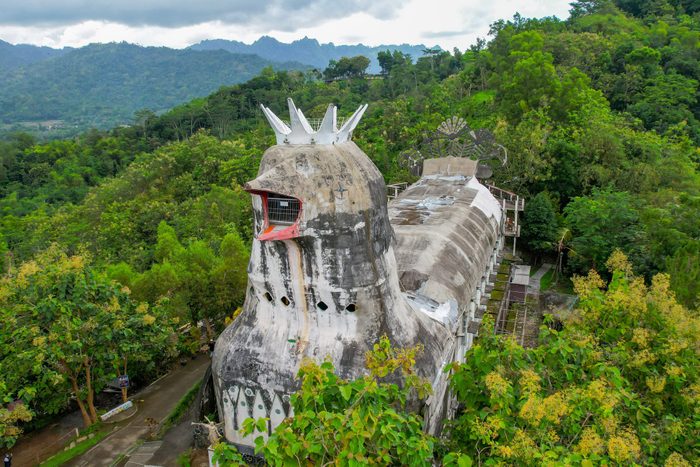
Gereja Ayam
Location: Java, Indonesia
This has to be one of the most unique abandoned places in the world. You’ll find Gereja Ayam, which translates to “chicken church,” on the island of Java in Indonesia. It was built after a man named Daniel Alamsjah had a vision of a dove-shaped place of worship for all religions back in 1988. He bought land on Bukit Rhema and work began on his divine dream. However, after nearly a decade, construction was halted in 2000 due to financial difficulties. The building was abandoned, a curious structure perched on a hill.
Even though Alamsjah’s plan was to have the church embody a dove, it was nicknamed “Chicken Church” because of its resemblance to, well, a chicken. The tale of its distinct structure attracted tourists, and funding for construction flowed once Alamsjah started charging a small entrance fee. Building resumed, and now Chicken Church is a full-fledged structure—it even features a cafe!
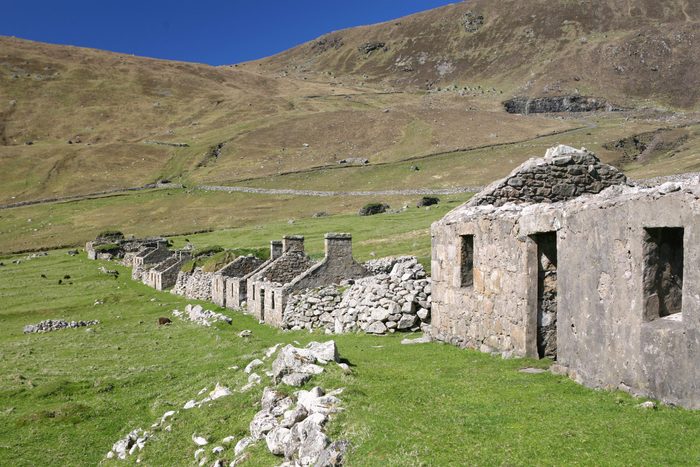
St. Kilda
Location: Outer Hebrides, Scotland
St. Kilda is one of those abandoned places that sticks with you long after you scroll past its hauntingly beautiful photos. The secluded Scottish island, located 40 miles west of the Outer Hebrides, is believed to have been home to humans for at least 4,000 years. Locals lived on the crag-clad island and survived by eating the meat and eggs of the large seabird population, along with oats, potatoes and barley. St. Kilda is undoubtedly gorgeous, but its extreme remoteness made life on the island difficult, especially during periods of bad weather.
By 1930, only 36 people lived on St. Kilda, a sharp decline in population as many residents moved to embrace an easier way of life. Realizing their lifestyle simply couldn’t be sustained on the island, the remaining inhabitants of St. Kilda asked the Scottish government to relocate them. The government complied, and the last residents of St. Kilda were evacuated in August 1930.
Tourists can still see the remnants of human life on St. Kilda more than 90 years later. Ruins of stone buildings still stand, and the seabird population still thrives, including the largest colony of Atlantic puffins in the United Kingdom.
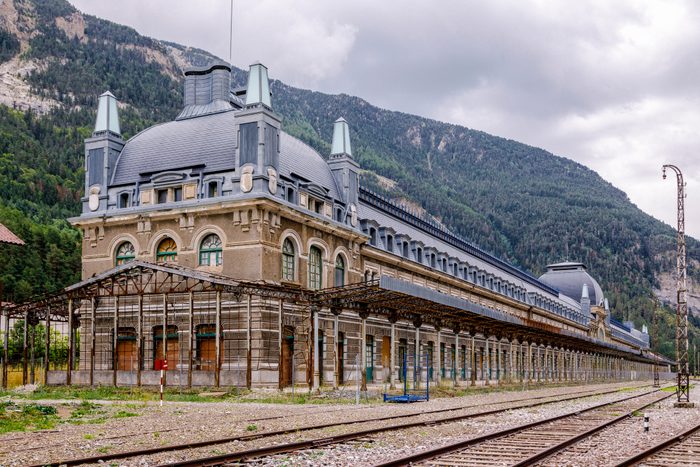
Canfranc railway station
Location: Canfranc, Spain
The Canfranc railway station in Spain has to be one of the unluckiest abandoned places on this list. Construction was completed in 1928, with the Spanish government hoping it would show off the country’s grand building capabilities. When completed, it was the largest railway station in Europe, showing great promise with the bustling cross-border traffic between Spain and France. However, several events lessened the station’s allure: the 1929 economic downturn, a fire that severely damaged the station just two years after its opening, the breakout of the Spanish Civil War in 1936 and then World War II taking the global stage.
The two decades following World War II saw station activity return, but alas, it wouldn’t last long. A 1970 train derailment caused significant damage to a bridge and shut the railway down, sparking the station’s eventual abandonment. The glorious station filled with lost promise was left to the elements, but it’s now getting a second chance—this time, as a hotel. Plans are in place to turn the station, nicknamed the “Titanic of the mountains,” into a luxury hotel.
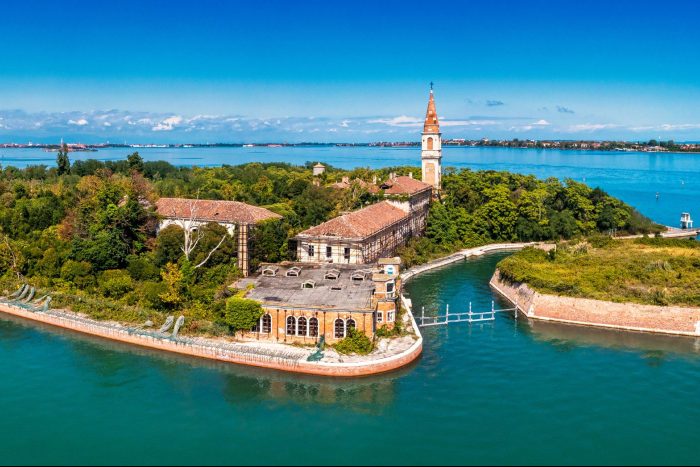
Poveglia
Poveglia, a small Italian island located in the Venetian Lagoon, has one of the eeriest backstories on this list of abandoned places. It was used as a quarantine spot in the 18th and 19th centuries, housing those sick with infectious diseases. It’s estimated that more than 160,000 plague-infected people perished on its soil. A mental asylum was also established on the island in 1922 but closed its doors in 1968; the island has been abandoned ever since.
Some believe the spooky island is haunted, given its morbid history. It’s been spotlighted on several paranormal investigation TV shows and YouTube videos. Alas, Poveglia is closed to the public, so don’t make plans for a ghost hunt of your own.
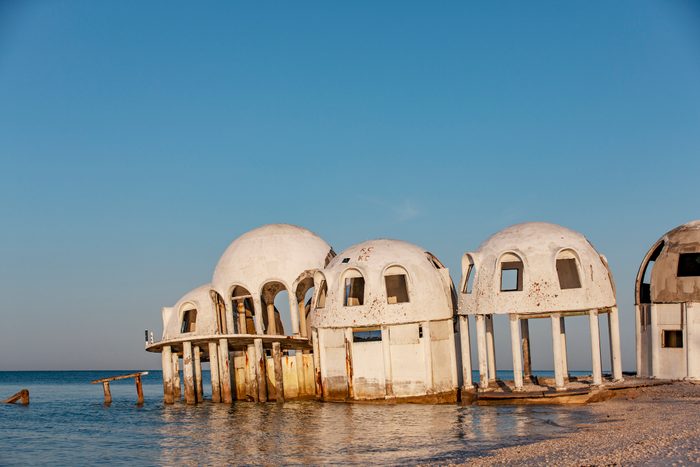
Cape Romano dome house
Location: Marco Island, Florida
Tourists to Marco Island may have been familiar with the Cape Romano dome house. The unique, can’t-miss structure was built in 1982 by an oil producer and changed ownership before it was abandoned in 1994. A buyer came through in 2005 with plans to bring the dome house back to its original glory, but plans were sidelined after Hurricane Wilma. By 2022, several hurricanes had chipped away at the dome house, with Hurricane Ian finally thrashing the last of its remnants into the sea.
For even more chills, check out these creepy abandoned amusement parks next.
Additional reporting by Tina Donvito and Kelly Kuehn.
